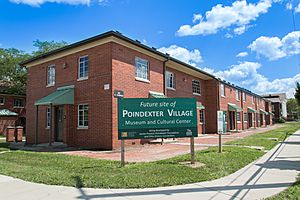Poindexter Village facts for kids
Quick facts for kids Poindexter Village |
|
|---|---|

One of two remaining buildings
|
|
| Location | 290 N. Champion Avenue, Columbus, Ohio |
| Coordinates | 39°58′19″N 82°58′04″W / 39.972060°N 82.967794°W |
| Status | Partially demolished |
| Units | 35 |
| Constructed | 1940 |
| Demolished | 2013 (partial) |
| Governing Body |
Columbus Metropolitan Housing Authority |
Poindexter Village was a very important group of homes in the King-Lincoln Bronzeville neighborhood of Columbus, Ohio. It was a place where many African American families lived and thrived. Today, two of its original buildings are being turned into the Poindexter Village Museum and Cultural Center.
This village was the first public housing project in Columbus. It was also one of the first of its kind in the entire United States. The community was named after James Preston Poindexter. He was a brave leader who worked to end slavery and was also a Baptist minister in the city.
Contents
What Was Poindexter Village?
Poindexter Village was built in an area of Columbus called the East Side. At that time, different groups of people often lived in separate neighborhoods. This project was created to give stable and safe homes to African American families. It helped many families become successful and achieve their goals.
A Special Community
The project opened in 1940. It had about 400 homes across 35 buildings on 27 acres of land. A well-known architect from Columbus, Howard Dwight Smith, helped design the buildings.
Poindexter Village was known as a strong and caring community. Neighbors helped each other, and people worked hard. Many residents became important leaders, doctors, teachers, and artists.
The village was named after James Preston Poindexter. He was an abolitionist, meaning he worked to end slavery. He was also a Baptist minister. Mr. Poindexter was a pioneer in Columbus. He was the first Black city council member and the first Black person on the city's board of education.
The Story of Poindexter Village
Poindexter Village officially opened on October 12, 1940. Even the U.S. President at the time, Franklin D. Roosevelt, visited for the opening. President Roosevelt had started many social programs, including the Federal Housing Administration, which helped create places like Poindexter Village. All the first residents were African American families.
Early Success and Later Challenges
For its first few decades, the housing project was very successful. It helped families move out of poverty. Many residents were able to save money and eventually buy their own homes.
However, in later years, the area faced some difficulties. Over time, some homes became empty. This led some people to suggest that Poindexter Village should be taken down.
Saving History
Around 2013, the Columbus Metropolitan Housing Authority decided to tear down most of the buildings. They hoped to build new things on the land. Thirty-three of the buildings were demolished.
But a group of people worked for nine years to save the two remaining buildings. In 2014, the James Preston Poindexter Foundation was started. Its goal was to share the important story of the housing project.
In 2016, the Columbus Landmarks Foundation listed Poindexter Village as one of the most endangered historic places in the city. Later that year, the Ohio History Connection voted to make the two remaining buildings a state historic site.
A New Future: The Museum
In 2017, the Ohio History Connection bought the two remaining buildings. The city of Columbus also gave $1 million to help fix them up. The plan was to turn them into the Poindexter Village Museum and Cultural Center.
The buildings were in poor condition and needed a lot of work. Windows, doors, and porches were replaced with new ones that looked just like the originals. The inside of the buildings were renovated, including setting up gallery spaces. The museum was completed by 2025.
The museum aims to teach visitors about the history of Poindexter Village. It also shares stories about famous African American residents of Columbus and the rich African American culture and history in the city. The site was officially recognized as a state historic site in July 2021.
See Also
- Hanford Village George Washington Carver Addition Historic District
- List of museums in Columbus, Ohio

